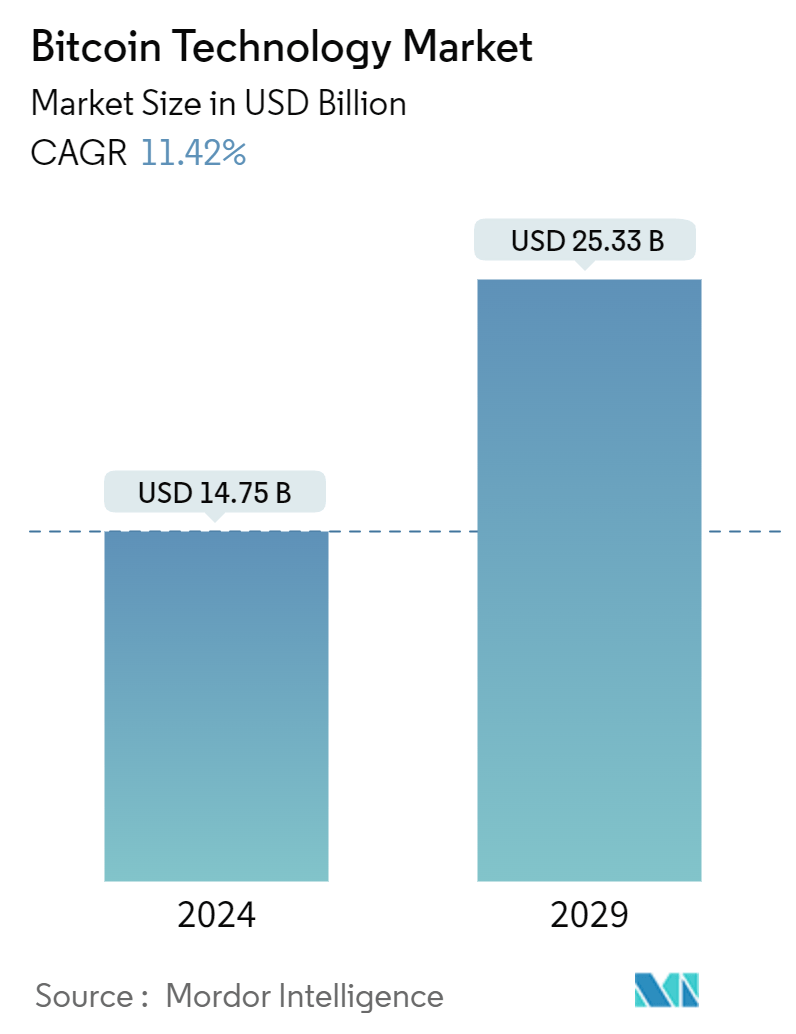Market Size of Bitcoin Technology Industry

| Study Period | 2019 - 2029 |
| Market Size (2024) | USD 14.75 Billion |
| Market Size (2029) | USD 25.33 Billion |
| CAGR (2024 - 2029) | 11.42 % |
| Fastest Growing Market | North America |
| Largest Market | North America |
| Market Concentration | Low |
Major Players
*Disclaimer: Major Players sorted in no particular order |
Bitcoin Technology Market Analysis
The Bitcoin Technology Market size is estimated at USD 14.75 billion in 2024, and is expected to reach USD 25.33 billion by 2029, growing at a CAGR of 11.42% during the forecast period (2024-2029).
The Bitcoin system was developed with the primary purpose of being finite. Therefore, inflation's threat reaches almost zero without the possibility of issuing excess currency. This point benefits both the seller and the buyer.
- Bitcoin payments have much lower transaction costs than purchases made with credit and debit cards. Small and medium-sized enterprises (SMEs) can benefit from this feature because they have a tight budget. Receiving bitcoins is free, and many wallets let users choose how much they want to pay in transaction fees. Higher fees may encourage a transaction to be confirmed more quickly.
- In 2008, the concept of bitcoin was first introduced, and as of April 2022, the market cap of bitcoin is around USD 821.13 billion (according to various exchanges). Blockchain estimates about 19 million bitcoins are in circulation as of April 4, 2022.
- A significant amount of bitcoin transactions were witnessed in the United States in 2021, as per Cambridge Centre for Alternative Finance. Additionally, the ascent of Bitcoin was supported mainly by speculative investors. Such high volatility of bitcoins has continued to help institutional investors.
- Bitcoins may be taking another step toward mainstream adoption. For the first time, customers of some US banks will soon be able to purchase, hold, and sell bitcoin through their current accounts, according to New York Digital Investments Group, NYDIG. Until now, bitcoin adopters relied on the app from the new generation of fintech players such as free trading brokerage Robinhood, payment giants PayPal and Square, or crypto-centric firms like Coinbase. On the other hand, banks have steered clear of Bitcoin for retail customers and only recently announced plans for allowing wealthy wealth management clients to wager on cryptocurrency.
- The growing interconnection between the existing financial system and a developing crypto ecosystem raises worries about spillover effects that may affect systemic stability. Although it now indicates differently, cryptocurrencies have long been a tool for diversification. The International Monetary Fund (IMF) published statistics earlier in 2022 showing a relationship between bitcoin and the S&P 500. This fuels worries about investor sentiment transferring from the stock market to cryptocurrency.
- Another area for improvement with cryptocurrencies is how bitcoins have responded to global emergencies. Russia's attack on Ukraine has sparked huge global support, with Bitcoin donations being poured into Ukrainians. It also prompted Russia's alleged use of Bitcoin to bypass economic restrictions imposed by numerous countries around the world. This presents a novel problem for corporations in determining whether monies leaving their platforms are used for illegal conduct.
Bitcoin Technology Industry Segmentation
Bitcoin is a consensus network that enables a new payment system and is entirely digital money. It is the first decentralized peer-to-peer payment network powered by its users with no central authority or intermediaries. Bitcoin can also be seen as the most prominent triple entry book-keeping system, which is now used in sectors like BFSI, E-Commerce, and Hospitality.
The bitcoin technology market is segmented by service (exchanges, remittance services, payment, and wallet), end-user vertical (BFSI, e-commerce, media & entertainment, and hospitality), and geography (North America, Europe, Asia-Pacific, and Rest of the World). The market sizes and forecasts are provided in terms of value in USD for all the above segments.
| By Service | |
| Exchanges | |
| Remittance Services | |
| Payment & Wallet |
| By End-user Vertical | |
| BFSI | |
| E-Commerce | |
| Media & Entertainment | |
| Hospitality |
| Geography | |
| North America | |
| Europe | |
| Asia | |
| Australia and New Zealand |
Bitcoin Technology Market Size Summary
The Bitcoin technology market is poised for significant growth, driven by its increasing adoption and integration into mainstream financial systems. The market is characterized by the development of blockchain and distributed ledger technologies, which are enhancing the efficiency and security of financial transactions. This growth is further supported by the rising interest from small and medium-sized enterprises, which benefit from lower transaction costs compared to traditional payment methods. The market's expansion is also fueled by the involvement of major financial institutions and banks, which are beginning to offer Bitcoin-related services to their clients, thereby bridging the gap between traditional finance and the cryptocurrency ecosystem.
North America is a key region in the Bitcoin technology market, with substantial investments in mining and blockchain infrastructure. The region's regulatory environment is becoming more favorable, with governments taking steps to promote the use of Bitcoin technology. This has led to increased awareness and adoption among businesses and consumers. The market is also witnessing the emergence of startups that are innovating in the Bitcoin space, offering new services and solutions that cater to the growing demand for cryptocurrency transactions. As traditional financial companies continue to explore crypto payment options, the market is expected to see further expansion and diversification, with Bitcoin playing a central role in the future of digital finance.
Bitcoin Technology Market Size - Table of Contents
-
1. MARKET DYNAMICS
-
1.1 Market Overview
-
1.2 Introduction to Market Drivers and Restraints
-
1.3 Market Drivers
-
1.3.1 Decentralized and Borderless Payment System
-
-
1.4 Market Restraints
-
1.4.1 Highly Volatile Currency
-
-
1.5 Industry Attractiveness - Porter's Five Forces Analysis
-
1.5.1 Threat of New Entrants
-
1.5.2 Bargaining Power of Buyers/Consumers
-
1.5.3 Bargaining Power of Suppliers
-
1.5.4 Threat of Substitute Products
-
1.5.5 Intensity of Competitive Rivalry
-
-
-
2. MARKET SEGMENTATION
-
2.1 By Service
-
2.1.1 Exchanges
-
2.1.2 Remittance Services
-
2.1.3 Payment & Wallet
-
-
2.2 By End-user Vertical
-
2.2.1 BFSI
-
2.2.2 E-Commerce
-
2.2.3 Media & Entertainment
-
2.2.4 Hospitality
-
-
2.3 Geography
-
2.3.1 North America
-
2.3.2 Europe
-
2.3.3 Asia
-
2.3.4 Australia and New Zealand
-
-
Bitcoin Technology Market Size FAQs
How big is the Bitcoin Technology Market?
The Bitcoin Technology Market size is expected to reach USD 14.75 billion in 2024 and grow at a CAGR of 11.42% to reach USD 25.33 billion by 2029.
What is the current Bitcoin Technology Market size?
In 2024, the Bitcoin Technology Market size is expected to reach USD 14.75 billion.

